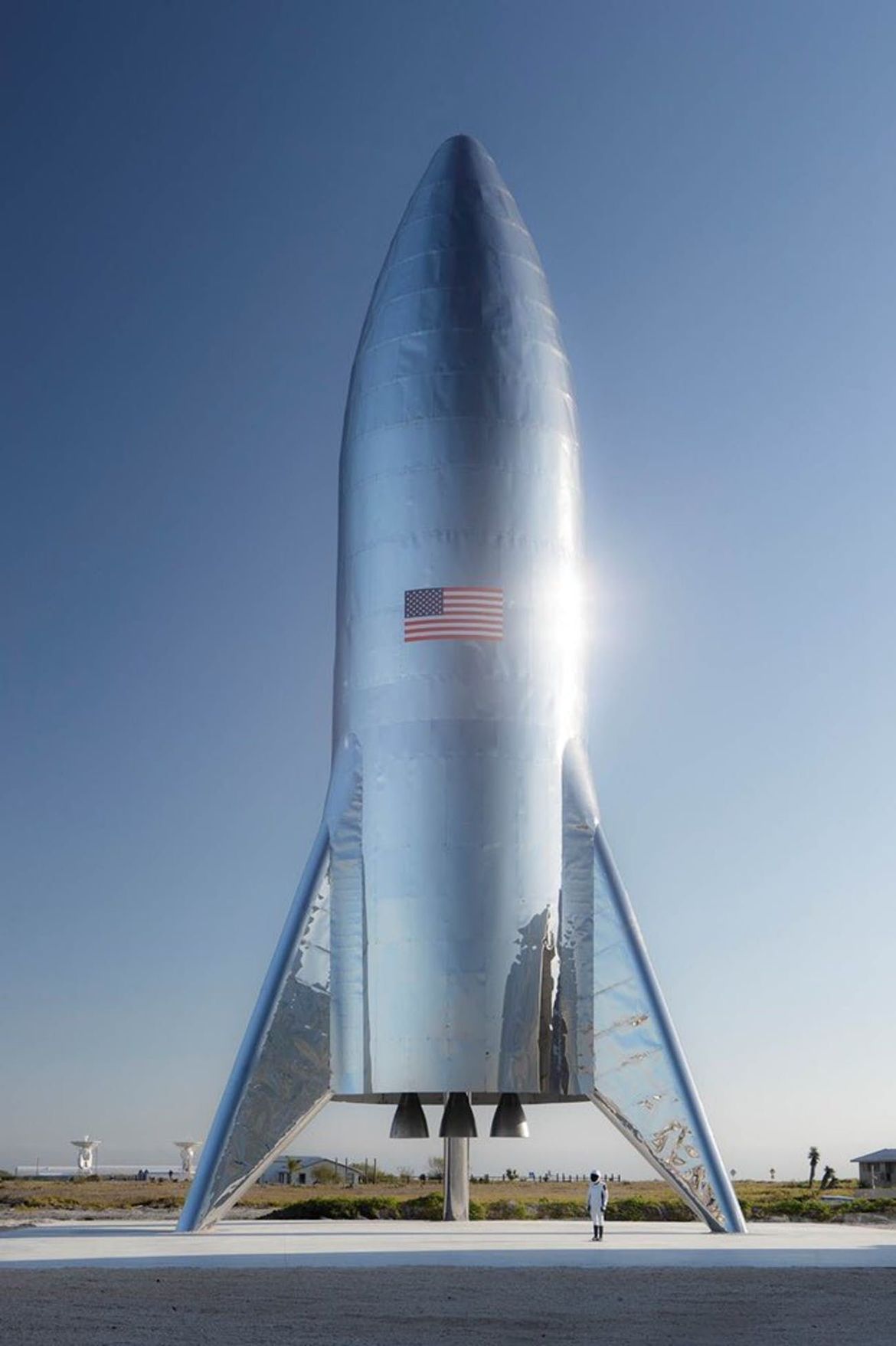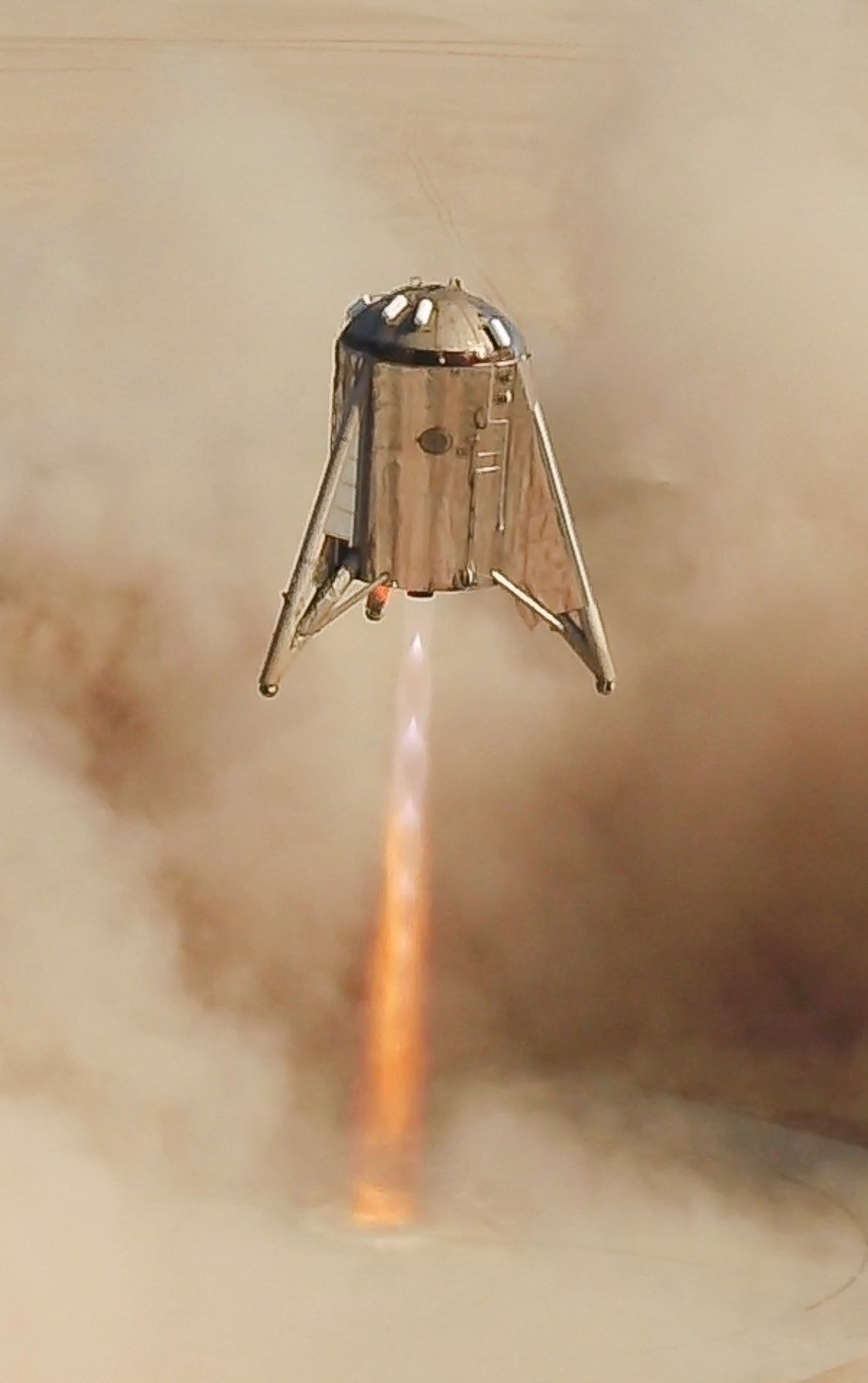Amazing Video: SpaceX Starhopper test hop to a height of 150 meters – SYFY WIRE

The SpaceX Starhopper test vehicle during its 150-meter test flight on August 27, 2019. Credit: SpaceX (captured from the live video stream)
Contributed by
Aug 28, 2019
Yesterday (August 27, 2019), at the South Texas Launch Site in Boca Chica Village, SpaceX successfully sent its Starhopper test vehicle on a flight that lived up to the second half of its name: It lifted off vertically, climbed to a height of 150 meters, scooted sideways a bit, and landed once again. The entire hop took less than a minute.
But it’s something to behold. It was live streamed on the SpaceX website, and :
Wow. That was amazing.
The test hop was originally scheduled for Monday, August 26, but a faulty igniter caused the launch to be shut down right when the countdown clock hit 0. They had to scrub, but they worked the problem and got the vehicle off the ground the next day.
OK, there’s a lot to parse here.
First, Starhopper is the test vehicle for , SpaceX’s next generation rocket. A rocket in its own right, it’ll be launched on top of the Super Heavy rocket booster (informally called BFR for Big Falcon Rocket, if you believe that). The idea is that it’s a fully reusable second stage vehicle that will take crew and cargo into space and be able to land again on its own. Eventually, Starship will be about 9 meters wide and 55 tall, which is enormous (the first stage is an additional 63 meters high, so the whole stack is nearly 120 meters tall, a bit taller than a Saturn V).

The original version of Starhopper before the nose cone was damaged in high winds. Credit: SpaceX
Starhopper is a smaller version of Starship. It originally had a long nose cone, but that was damaged in high winds, so SpaceX decided to test it without the nose. Starhopper stands roughly 20 meters high.
It uses a single Raptor engine, a new design of engine that has never been flown before (). It burns liquid methane, with an eye towards Mars: Although it’s never been tested (of course), theoretically methane can be generated on Mars from ice in the ground and carbon dioxide in the air using . As Elon Musk has been clear about for a while, he wants to send humans to Mars. As difficult as that is, getting them back is the really hard part. Fuel is heavy and means you’d need to take a vast amount with you to be able to carry the return trip fuel. It’s hugely more efficient to make the fuel wherever you land, and that’s a big reason the Raptor is designed the way it is.

The SpaceX Starhopper test vehicle during its 150-meter test flight on August 27, 2019. Credit:
Also, the Raptor, once fully operational, should produce twice the thrust as the Merlin engines being used for the Falcon 9 and Falcon Heavy. The Super Heavy + Starship combo is massive (Starship may carry up to 100 passengers), so extremely powerful engines will be needed. When completed, Starship is planned to have 6 such Raptor engines, and the Super Heavy 35. That’ll be quite the sight at launch.
Originally, Starship was going to be made of carbon fiber, which is lightweight and strong. However, early in 2019 Musk made the surprising announcement that they were switching that to stainless steel. I thought this was a joke at first (Musk does joke a lot and it’s hard to know when he’s being serious), especially since the old movies I grew up with always had a spaceship made of something silvery and shiny, like steel (based on space artist ).
But it turns out that steel has a lot of advantages on a ship this size. It’s strong, is less expensive to make, easy to fix, and . The idea is to have a double-walled hull of steel with a liquid in between the layers (water, or perhaps even fuel). It can be bled out of tiny holes in the outer layer and evaporate, cooling the rocket; this is called (similar to how we sweat).

The SpaceX Starhopper test vehicle just before landing during an August 2019 test flight. Credit:
Obviously this is all very innovative and experimental. The good news is the Starhopper test flight appeared to go well. The engine seemed to perform up top spec; it’s mounted on a gimbal that allows the direction it points to change, moving the ship. This is called Thrust Vector Control, and you can see it on the video as the exhaust plume moves to the right, pushing the vehicle to the left.
A previous test took Starhopper to a height of 20 meters, showing . There will be more tests (with orbital prototypes) coming soon, and Musk has said he hopes to have the first operational flight of the stack in 2021. SpaceX is rather well known for slipping launch dates (what they’re attempting isn’t easy), so I won’t be surprised if that’s actually a year later. Either way, it’ll be neck-and-neck with the first launch of NASA’s SLS, the agency’s heavy lift vehicle. My opinion on that is well documented.
Ironically, this test comes on the day that asking that they be given more leeway about choosing the launch vehicle for the upcoming Europa mission. The hardware for that mission should be complete in 2023, but due to the Artemis Moon program an SLS won’t be available to launch that mission until 2025 at least. That means storing the Europa mission spacecraft for two years (honestly, more, since SLS keeps slipping in schedule), which is not cost effective and increases risk for damage. Offsetting this is that SLS will be powerful enough to send it on a direct trajectory to Jupiter in less than three years, whereas a commercial rocket (like from SpaceX) would take more than 5, using gravity assists (the so-called ‘slingshot’ maneuver). I’ll be very curious to see how Congress (especially Sen. Richard Shelby of Alabama, who has made very sure SLS is managed in his state) reacts.
Anyway, this Starhopper test flight was perhaps short in height, but has tall implications for the future… and not the distant future, either. It’ll be very interesting to see what the next couple of years bring for SpaceX and NASA.








